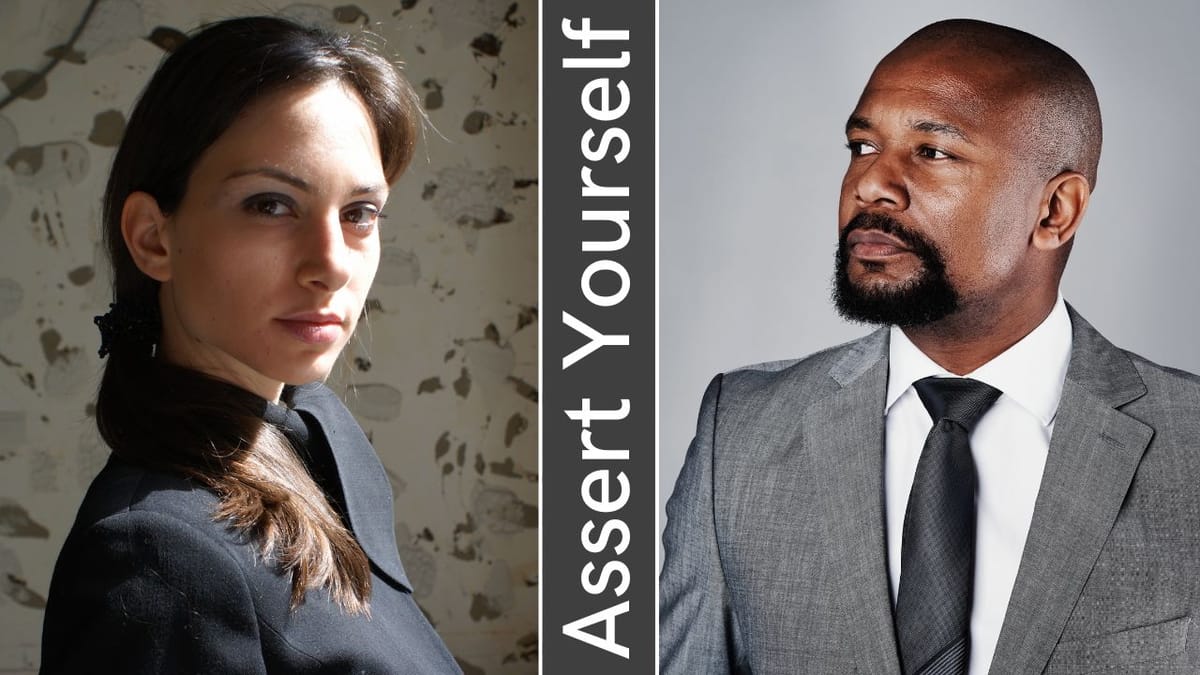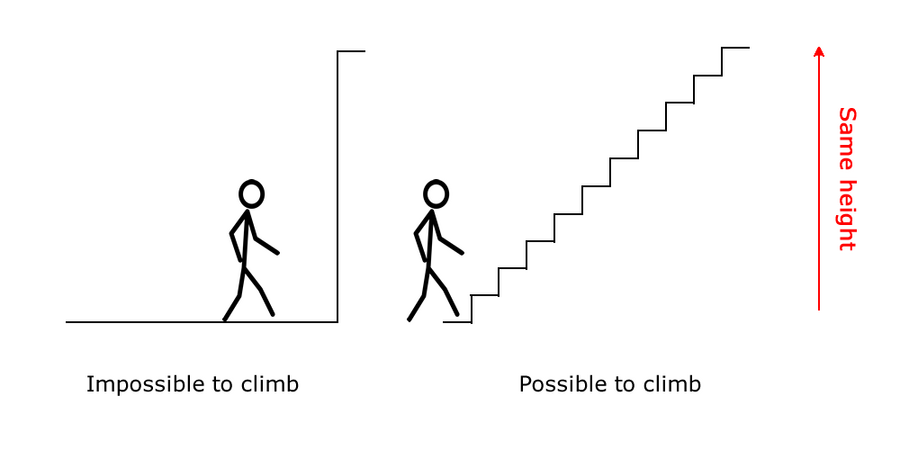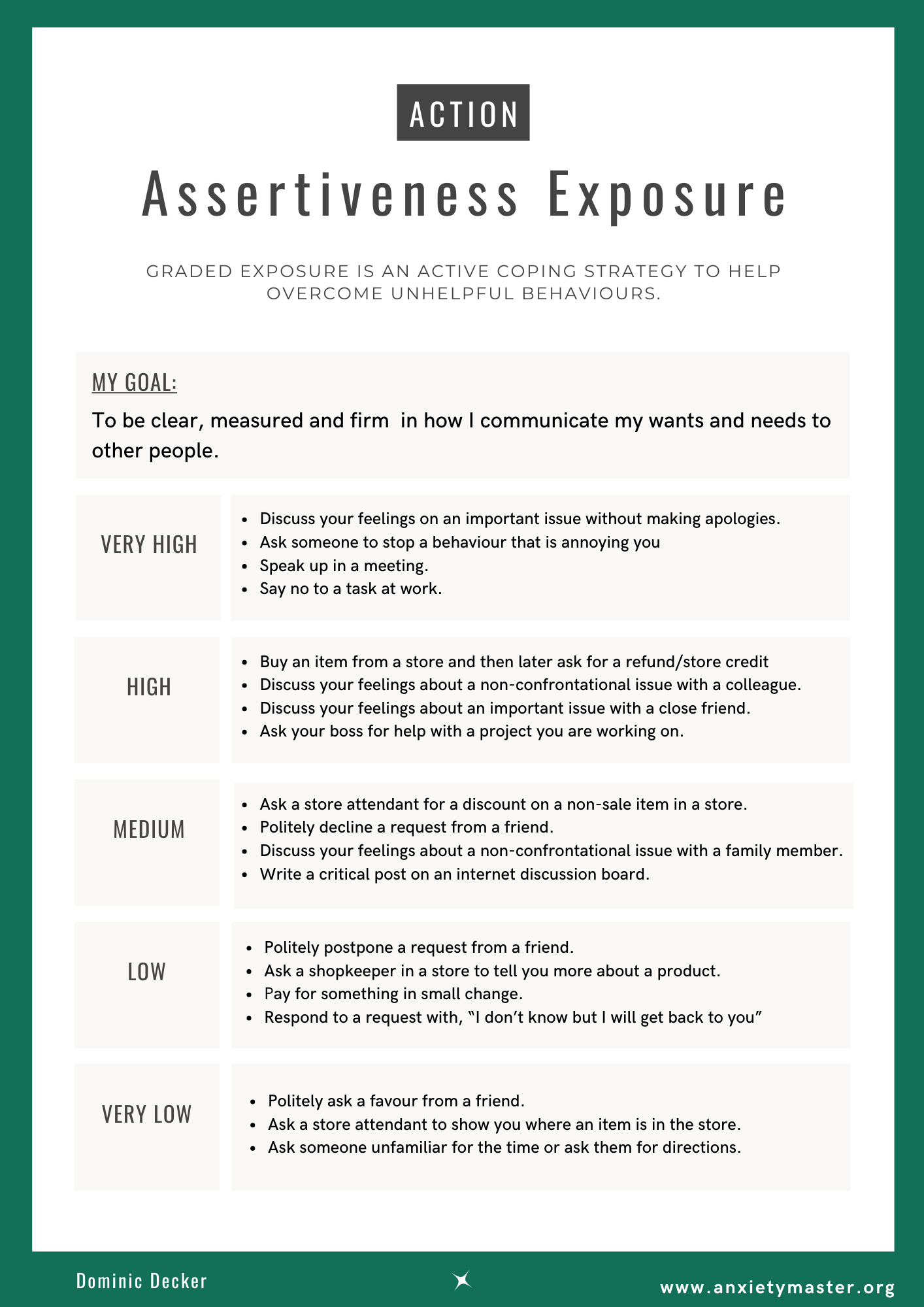Say What You Mean & Mean What You Say: A Complete Therapist Guide to Assertive Communication

Action: Practice this guidance and dramatically improve your assertive communication skills.
Content: We'll cover tried-and-tested strategies to upgrade your daily interactions.
Results: An observable improvement in how others respond to you as well as demonstrably better responses to your requests. Personal and professional satisfaction along with enhanced self-perception.
Managing relationships with other people is complex. When inevitable friction arises, poor communication may compound the problem and generate more stress.
You want the other person to see and understand you. Yet, in heated moments, what you see as assertive may easily be misread as aggressive.
Misunderstandings lead to frustration, and then annoyance lights the fuse for overheated responses.
As a result, you risk saying the wrong thing or withdrawing and not saying anything at all. Either way, the possibility of taking or giving offence is a dissatisfying state of affairs.
Equally, you may shy away from expressing your feelings in heated situations.
Instead, you downplay the value of your thoughts and needs to avoid discomfort or protracted conflict. Yet this withdrawal feels like surrender, breeding frustration and self-disappointment because it isn’t who you want to be.
Let's move beyond this.
This article outlines how to communicate your needs, concerns, and frustrations.
It will show you how to express your position with a level head, an even temper, and a clarity of purpose. From minor daily interactions to work negotiations, let's upgrade your assertive communication skills.
Content:
- Why People Struggle to Assert Themselves
- Four Types of Communication
- Benefits of Assertive Communication
- Set-up for Success - Graded Exposure
- A LADDER to Get Started
- Importance of Body Language
- Assertive Complaining (without hurting feelings)
- Advanced Assertiveness Skills (to manage bothersome people)
How do you communicate - and why?
Assertiveness is a tangible skill you can develop, yet many of us struggle to put it into practice.
This doesn't reflect a personal failing. Instead, the challenge of developing your own assertiveness points to the power of past experiences and social influences.
Understanding the causes of the habits we want to change can lead to more meaningful results. First, it helps to decipher the emotional roots of your current communication that you may feel is timid, incomplete, or less than.
Childhood Experience
Generally, communication patterns stem from - and are determined by - early life experiences.
For instance, consider a child on the receiving end of unregulated adult behaviour.
If a parent is given to rash, unpredictable reactions or tends unfairly to blame their offspring for any difficulty, then such conduct will leave a child confused and uncertain.

The child focuses their efforts on avoiding upset to pre-empt blame or criticism.
This strategy results in passive and obedient behaviour to ward off danger. Yet these childhood safety-maintenance habits often develop into over-compliance in adult interactions.
Emotional Pattern-Matching
Early experience of emotionally erratic communication with significant adults often causes low self-esteem. A child who is unclear of their rights may become an adult hesitant to express their needs.
In the face of conflict, a submissive person may feel emotionally flooded or overwhelmed. This results in their retreat to avoid upset or discomfort.
Thus, the presenting issue remains unresolved, perhaps to the extent that a tendency to sidestep confrontation until it becomes unavoidable mutates into aggressive over-compensation.
Here, the built-up pressure may explode with an angry, inappropriate or damaging outburst.
The aftermath of conflict leads to confusion and regret, especially for the aggressor. This ensuing upset carries echoes of distress from the parent-child relationship.
Hence, a connection between trying to assert oneself with guilt and shameful consequences is further embedded.
Social Expectations
Social and cultural norms can discourage open and direct communication. This is especially true in environments that value conformity over individual expression.
Example: Work environments that promote compliance may reinforce a passive or passive-aggressive style. Here, asserting oneself is a threat to the hierarchy, and assertiveness may entail the risk of firing, expulsion, or rejection.
Sometimes, staying quiet means keeping safe. That said, it may be time to move on anyway if that's the only option in your place of employment.
To begin, it helps to analyse how you generally communicate.
Four Types of Communication
Four typical communication styles are aggressive, passive, passive-aggressive and assertive.
Aggressive Style: In aggressive communication, you state your opinions, feelings, and needs. The tone is often blunt and comes at the expense of others.
You come across as rude or demanding - even offensive.
Aggressive communication provokes adverse reactions that lead to stress for everyone. Thus, bar dangerous situations, it's rarely the appropriate manner to use.
Passive Style: Next is passive communication. Here, you avoid expressing your opinions, feelings, and needs. You may be uncomfortable speaking your mind. This is especially true when dealing with supervisors or people you deem important or superior.
When passive, you don't take part in decisions that affect you. Furthermore, you don't take a stand on issues that are important to you.
This results in you leaving meetings feeling under-acknowledged or invisible. Passive communication incurs the cost of not feeling seen and heard.
Such a loss of control and agency to direct events generates frustration and stress.

Passive-Aggressive Style: Next is passive-aggressive communication. This manifests as indirect aggression.
For instance, you may agree to something you don't want to but with an annoyed tone. You may also use sarcasm to express irritation to avoid clear communication.
Passive-aggressive communication might get your wants recognised. Yet this approach risks coming across as insincere. Disingenuous behaviour irritates others or comes across as manipulative.
Assertive Style: And, finally, there is assertive communication. Assertive communication involves sincere statements about your opinions, feelings, and needs.
You convey your position in a respectful, discreet, and thoughtful way. You're understood and well-received.
How Do You Communicate? Consider these questions:
What communication style do you usually use (aggressive, passive, passive-aggressive or assertive)?
- How does that tend to make you feel?
- Do you get the outcomes you desire?
- What would the benefits of assertive communication be?
Horses for Courses
We each use different communication styles for various situations. The form we adopt varies depending on who we're talking to. Yet, in most situations, a clear and transparent assertive style is generally the healthiest approach.
Balanced candour helps you stand up for yourself without offending others. Level-headed self-expression also enables you to feel more in control of a situation.
You know where you stand; others know where they stand, too.
The outcome is a well-regulated relationship with yourself and those around you.
Assertive Benefits
There are other benefits of assertive communication.
- Be more comfortable with supervisors at work.
- Find that your views are more respected.
- Be more effective in having your needs met.
- Feel more confident about asking others for help.
- Feel less angry toward others.
- Find that you are more comfortable with saying "no."
Assertiveness - Unrealistic Expectations
Often, without realising it, you might hold unrealistic beliefs about being assertive. This confusion deters you from becoming assertive.
It's helpful to remember:
You don't have to always agree with your friends to be a good friend (people usually prefer candour).
You don't have an obligation to agree with or say "Yes" to people.
You don't have to offer reasons or 'excuses' for saying "No".
Your needs are as important as other people's needs
Saying "No" to something means saying "Yes" to something else.
So, to be more assertive, you focus on what you say and how you say it.
Assertiveness - Setting Yourself Up for Success
It's not uncommon to assume that you're either assertive or you’re not. This assumption makes the gap from being passive to becoming assertive too large to bridge.

But assertiveness isn't a switch we turn on and off. Instead, it's a skill that's developed and honed over time. And, with practice, it will become second nature.
Like all good habits that we practice over and over, your aim is to build assertiveness over time.
Graded Exposure is one of my favourite therapeutic tools for developing assertiveness.
Assertive Graded Exposure
Graded Exposure is an active coping strategy to help overcome unhelpful behaviours.
For instance, the model is good for reducing perfectionism and procrastination.
In this case, we're using it to develop assertiveness.
The strategy involves several steps. First, you set a goal. Next, you plan steps or 'behavioural experiments' to reach that goal.
Before you undertake a step, you note what you think will happen.
For instance, 'If I ask for a discount in a shop, the salesperson will think I'm stupid and not want to deal with me.'
Next, you test the assumption by carrying out the step. In most cases (I'd say, 90%), what you think would happen and what actually happens are different. By and large, the outcome will be much better than you anticipated.
Graded Exposure provides a range of benefits:
- You practice incremental skills to build the desired assertive behaviour.
- You learn that your worries are usually inaccurate and unrealistic.
- Each step increases the challenge - and ups the reward.
By developing your assertiveness, you become more competent and less stressed. Thus you have more time and mental focus to invest in relationships, opportunities and enjoyable activities.
However, practising graded exposure tasks does involve some anxiety. But you will find that this anxiety settles with time and becomes less intense with repetition.

To chart and record your progress, I recommend creating an Exposure StepLadder (Download a FREE template at the end).

1. Clarify your goal (e.g. to express your wants and needs and to be less concerned with the response of others).
2. Rank your list of activities and situations associated with your goal (from low to high stress).
3. Pick a low-level (easy) task and practise it using the 'exposure' approach.
Assertiveness: From Theory to Practice
If Graded Exposure is a strategy for cultivating assertiveness, let's explore a practical tool to implement this approach.
Use this Assertiveness LADDER to get Started.
Using an assertiveness ladder, you can plan and practice being more assertive. You can use the assertiveness ladder at home or at work. Use the letters of the word "LADDER" to recall the steps.
L: Look at your rights, what you want, and what you need. Define what you want, and keep it in mind during your discussion.
A: Arrange a time and place to discuss the situation. You can skip this step if the situation isn't planned, such as receiving the wrong food at a restaurant.
D: Define the problem for the other person. Don't assume the other person already knows about the problem.
D: Describe your feelings using "I" statements. An "I" statement tells how you feel without blaming someone else. For example, try saying, "I'm feeling frustrated," instead of "You frustrate me."
E: Express what you want or need. Be specific, brief, and firm. For example, instead of asking your partner to be "more considerate," ask him to call if he'll be more than 15 minutes late.
R: Reinforce the idea of getting what you want. Show the other person how your request might benefit both of you.
Non-verbal Communication
Of course, verbal communication is only one piece of the pie.
Some formulas estimate the interpretation of a spoken message is 7 per cent verbal, 38 per cent vocal and 55 per cent visual. So, 93 per cent of communication is "non-verbal".
Using assertive body language
Body language is how you sit, stand, move, and use your eyes and hands when speaking. Sometimes, you think you're being assertive, but your body presents a conflicting message.
That message can get in the way of what you are trying to say. Using the correct body language helps you communicate with greater confidence.
Keep these pointers in mind:
- Make eye contact with the person you're talking to. Try to keep your facial expression open and sincere.
- Sit or stand up tall with a straight back. Speak with a clear and firm tone.
- Use your hands and facial expressions to highlight your most important points.
- Try not to sound like you're asking a question when you're not. You'll recognize this when your intonation rises at the end of sentences.
- Don't use an apologetic tone of voice.
Practising your body language in front of a mirror can be helpful.

It's normal to feel anxious when you start practising assertive communication. This is why it can help to begin with an easy task first, for example, practising with a close friend.
Here's a simple three-step plan to practice and rehearse.
Assertive Complaining (Getting what you want without hurting someone's feelings)
When you complain, you want to feel:
- Heard.
- Understood.
- The matter can be put right.
However, you might avoid expressing your thoughts for fear of hurting the other person.
A good complaint should empower the other person to repair the situation. From this perspective, your complaint attempts to restore mutual trust and understanding. Let this be your guiding light.
So how do we do it?
Step 1: Start with ‘I’ and express the feeling.
‘I’m upset, worried, angry ...’
Step 2: Describe the situation and stick to the facts
‘I’m upset that I get interrupted when I talk.’
‘I’m disappointed that you didn’t come home like you said.’
‘I’m annoyed that I have to keep repeating myself.’
Describe yourself and the situation. Not the other partner.
Step 3: Express what’s needed
How can the other person make it better?
Make this clear and practical.
‘I need you to ...’
Your request should position the other person to repair and put things right.
Examples:
‘I’m upset that I get interrupted when I talk. I need you to let me finish speaking.’
‘I’m disappointed that you didn’t come home like you said. I need you to stick to our agreement.’
‘I’m annoyed that I have to keep repeating myself. I need you to listen to me carefully.’
Everything we've covered so far will offer you a clear passage through many situations.
Yet there are occasions when you need to go that step further to maintain calm and keep control.

Here you might want to reach into your bag for advanced assertiveness techniques.
I'm talking about persistent time-grabbers and obnoxious bigheads. Then there are bolshy types and unaware lane shifters with no sense of boundaries.
Let's uncover some techniques to manage these situations.
Advanced Assertiveness Skills - Managing Bothersome People Like A Boss
Some occasions make it particularly hard to be assertive. For instance, if the other person is being irrational or aggressive. In these situations, you may need to improve your skills further.
Fear not. Familiarise yourself with the following techniques to bring tricky situations back under control.
Be a broken record. This is useful for when someone persists in asking something inappropriate of you.
What to do: Repeat yourself over and over until the other person accepts your answer. Don't give explanations or excuses. Instead, offer the same response with the same measured tone.
Three times will usually do it, but don't be perturbed if it takes more.
Fogging.
The term fogging derives from the metaphor of a 'wall of fog'—absorbing arguments without reciprocating them.

Fogging is an effective strategy when faced with manipulative or aggressive behaviour.
Rather than counter-arguing, the technique delivers short and calm responses. These responses are conciliatory but not defensive. Your aim is to circumvent conceding to unreasonable demands.
Fogging involves acknowledging valid points in the other person's statements, even if critical.
If you refrain from adopting a defensive position, you've sidestepped the expected response. As a result, the aggressor often discontinues an aggressive approach.
This shift can pave the way for more rational discussion once tensions have subsided.
Example Situation:
"What time do you call this? You're nearly half an hour late. I'm fed up with you letting me down all the time."
Fogging Response: "You're right, I am later than planned, and I understand it's frustrating for you."
"Annoyed? Of course,I'm annoyed, and I've been waiting for ages. You really should try to think about other people a bit more."
Fogging Response: "I agree, waiting for someone can be irritating, especially for nearly thirty minutes."
"Well... why were you late?"
Positive Inquiry
Positive inquiry involves embracing praise and compliments.
People with lower self-esteem often find it challenging to accept positive remarks. They might feel unworthy or doubt the sincerity of the compliment. Yet a gracious response to genuine praise is to accept a gift from someone.
Positive inquiry involves delving into the praise and concurring with it.
Example Situation
Giver: "You made an excellent meal tonight; it was delicious!"
Receiver: "Thank you. I'm glad you enjoyed it. Could you tell me what it was that stood out for you?"
Contrast this with a passive dismissal, such as, "Oh, it was nothing," or "It was only a basic recipe.'
These responses serve to undervalue the effort and the compliment.
Negative Inquiry
Negative inquiry is a constructive method for addressing criticism or negative comments.
Rather than a defensive or hostile response, negative inquiry aims to understand criticism.
Example Situation
Sender: "That meal was inedible. I can't remember the last time I ate something so awful."
Receiver: "I see it wasn't to your liking. Could you specify precisely what you don’t like?"
This approach contrasts with aggressive retorts like, "How dare you criticise my cooking after all the effort I put in!" or "Fine, I won't bother cooking for you again." These responses only escalate the situation.
Remember, becoming assertive requires practice. Like any skill, you'll get better at it with repetition. There will be occasions when it doesn't work and other times when you'll be pleased with its effectiveness and success.
Don't expect to become assertive overnight. Instead, stay committed through regular practice. You'll see and experience the benefits, for sure.
Becoming Assertive: A Final Thought
Learning to express your thoughts, wants and needs is the greatest of gifts.
Whatever your current station in life, it's never too late to start practising the skills in the article.
As soon as you begin, you step into the light. From unseen to seen. Becoming assertive is an act of self-compassion. In standing up for your position, you extend the care that you offer others to yourself.
What's more, you'll attract supportive people and repel negative ones. You've got everything to gain, so get cracking. One. Step. At. A. Time : )
And remember:
Be who you are say what you mean, because those who mind don't matter and those who matter don't mind. Dr Seuss.
Don't Forget Your FREE Resource!
Join the Anxiety Master Community for immediate access to your blank Graded Exposure Ladder.